Alison De La Cruz
- Artist Alison De La Cruz
- Alison's Art
- Contributor Adriana Alvarez
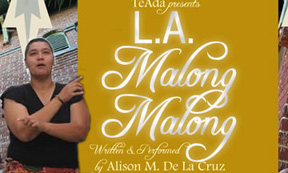
Alison M. De La Cruz is a multi-disciplinary theatre artist, arts educator and cultural organizer, whose passion is to tell stories. She currently lives in the South Bay and she is the Administrative Director for About Productions. She is also the Lead Teaching Artist for East West Player’s PEAC Program & Special Event Producer. De La Cruz first emerged in 1998 as a poet and spoken word artist at the Festival of Philippine Arts and Culture. Her first solo work was Sungka (2000), followed by As We Like It (2003), Naturally Graceful (2005), Grassroots Rising (2005), and other works. In 2007, De La Cruz worked with Adelina Anthony and D'Lo, who are queer solo artists, to create the Spotlight Stealerz. Another important work of her is LA Malong Malong (2011), a re-imagined, interactive fairy tale with its name derived from a Southern Philippines folkdance, and a performance that centers of the question: Who would you climb a tower for? She is currently working a new piece entitled Queers Live Happily Ever After in and amongst all of her other artistic, administrative and production work. She also works with talented artists to create, mobilize, and heal communities through the use of art. This is the main reason why I chose Alison for my research, because I admire artists that don't just express individualistic art, but art that focuses on the benefit and representation of communities.Alison De La Cruz is a multi-disciplinary theatre artist, arts educator and cultural organizer, whose passion is to tell stories. She currently lives in the South Bay and she is the Administrative Director for About Productions. She is also the Lead Teaching Artist for East West Player’s PEAC Program & Special Event Producer. De La Cruz first emerged in 1998 as a poet and spoken word artist at the Festival of Philippine Arts and Culture. Her first solo work was Sungka (2000), followed by As We Like It (2003), Naturally Graceful (2005), Grassroots Rising (2005), and other works. In 2007, De La Cruz worked with Adelina Anthony and D'Lo, who are queer solo artists, to create the Spotlight Stealerz. Spotlight Stealerz is a Los Angeles-based theatre/comedy performance troupe. Another important work of her is LA Malong Malong (2011), a re-imagined, interactive fairy tale with its name derived from a Southern Philippines folkdance, and a performance that centers of the question: Who would you climb a tower for? She is currently working a new piece entitled Queers Live Happily Ever After in and amongst all of her other artistic, administrative and production work. She also works with talented artists to create, mobilize, and heal communities through the use of art. This is the main reason why I chose Alison for my research, because I admire artists that don't just express individualistic art, but art that focuses on the benefit and representation of communities.
Sites used:
http://alisonmdelacruz.blogspot.com/2010/12/bio-for-alison-m-de-la-cruz.html
https://sites.google.com/site/alisondelacruzwebsite/Home/list-of-past-performances-1/de-la-the-actor
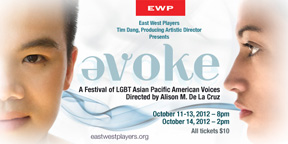
As a performance artist, Alison De La Cruz has not only performed, but has also produced her own works and at times participates in them as well. One of her most recent works is Evoke, a festival that focuses on the voices of LGBT Asian Pacific Americans to expand the dialogue about their experiences a diverse group. This festival reflects De La Cruz's intention to create work that nurtures new voices within queer, immigrant, student, and multicultural communities in Los Angeles. Alison is also an artist that focuses on the way race, culture, and place impact making-art in a collective context.
The flyer that is posted for the promotion of this festival is quite powerful. The person (left) is facing forward, and the other person (right) if facing the person on the left. the two are in the position as if the person on the right is talking to the person on the left, thus illustrating that this work is about dialogue and understanding that diverse differences within the APA community. The fact that the person on the right is facing the reader can also signify that the person is inviting the public to attend the event so that everyone can take part of this dialogue and to be aware of the differences and similarities of different cultures.
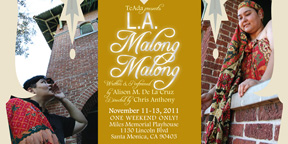
One of Alison De La Cruz’s newer solo works is LA Malong Malong. It was written and performed by the author in 2011. The performance is a queer version of Rapunzel. The play explores the question “Who would you climb a tower for?” and invites the audience to also explore the question. The main character, played by De La Cruz, is Zelle, a Princely Butch individual who knows “that she doesn’t feel at home in her own skin and she’s the one stuck in the tower.” In other words, Zelle’s body represents the tower in which the character is trapped and is waiting for something, or someone, to rescue her from the way she feels about her body. De La Cruz also expressed that a piece of this performance is inspired by—and takes part of its name from—a Southern Philippines folkdance. In this dance, the malong—a traditional tube skirt made of multi-colored cotton cloth—is able to convert into thirty different kinds of shapes and uses. This theme is used as an interesting metaphor for the gender roles and identities based on these roles. Therefore, Zelle becomes the malong in this play, in which the character changes shapes—which represent the different gender roles and identities.
Sites used:
http://eastwestplayers.wordpress.com/tag/alison-de-la-cruz/
http://teada.org/programs/la-malong-malong/
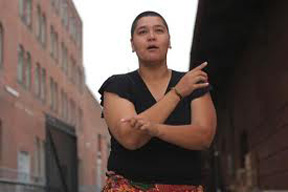
The Vagina Monologues
Alison De La Cruz has also participated in other performances, one being the play The Vagina Monologues, which was written in 1996 by Eve Ensler. It was in 1998 when Ensler also created V-Day campaign to raise funds for women's anti-violence groups. In her participation, De La Cruz was part of the all-Asian cast in March 2008, in which she performed "The Coochie Snorcher that Could" to fundraise for the Center for Pacific Asian Families. In this performance, she worked with other amazing artists, including Takayo Fisher, Lynn Chen, Cher Calvin, and Janet Choi. She returned to perform again in 2009 as was part of the all-Pinay cast, which included artists Cher Calvin, Tamlyn Tomita, Tatiana Ali, and Giselle Tongi. The character that Alison plays in this performance is of a woman from the South who discovers much about her sexuality, ultimately identifying herself as a lesbian. In other words, her performance is of a woman who starts with the life of a heterosexual woman and illustrates her journey as she realizes that she is a lesbian.
Sites used:
http://filamarts.org/content/artist-spotlight-alison-de-la-cruz
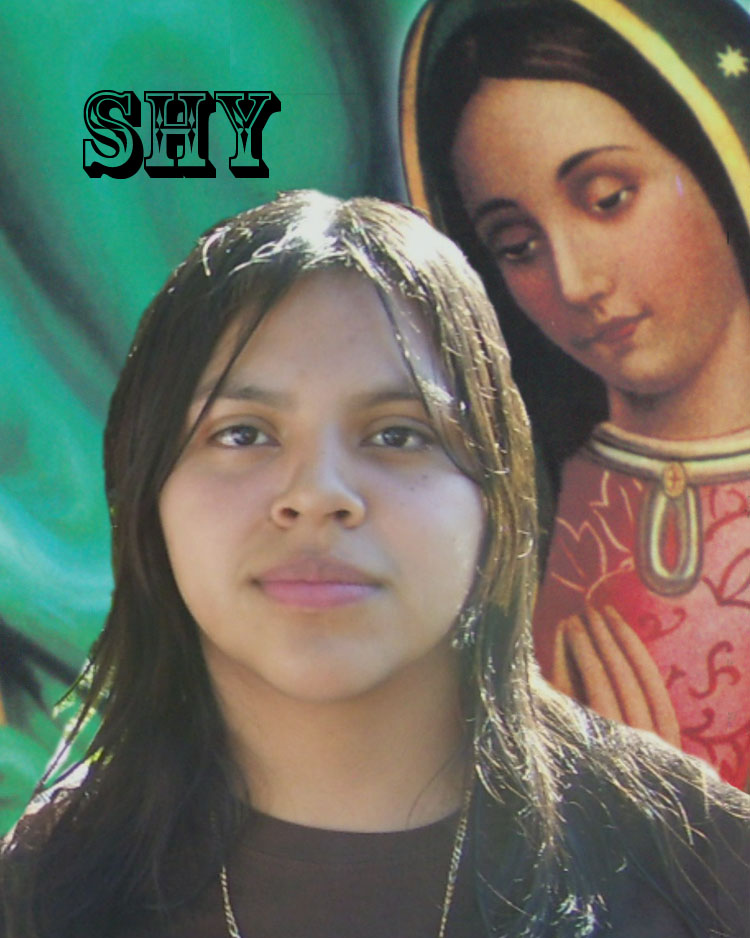
I am a fourth-year student at UCLA majoring in Chicana/Chicano Studies, with a concentration in Expressive Arts. I was born in Jalisco, Mexico in 1991 and came to the United States when I was 8 years old, specifically at Escondido, California. I am a first-generation student, and the youngest of 9 children.
So far, I am currently taking art classes with artist Alma Lopez and muralist Judith F. Baca. My goal is to work in the artistic world in order to raise awareness and educate the public about history and current issues that the Chicano/Latino community are facing through the form of art. After my undergraduate career, I want to attend graduate school and earn both my Master's and Ph. D degrees in Chicana/Chicano Studies. I want to have greater knowledge about Chicana/o artists and stud their works, so that I can take part in continuing their legacy in communicating and educating the public using artistic works, whether it is in painting, film, or any other form of art.


